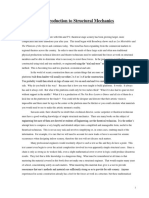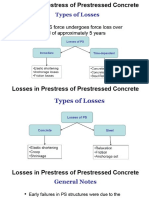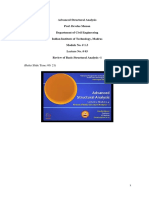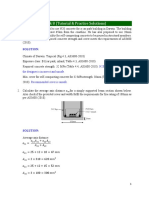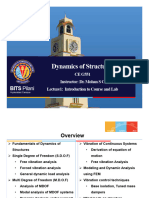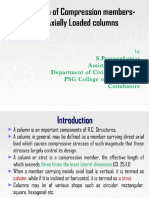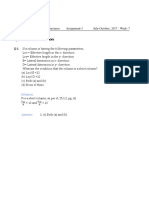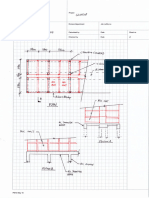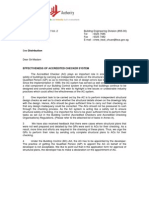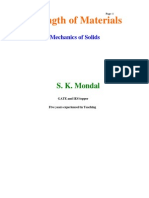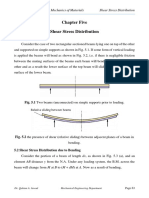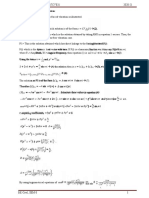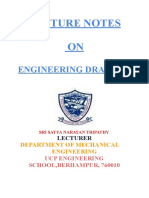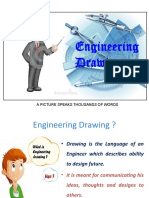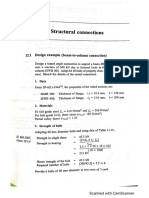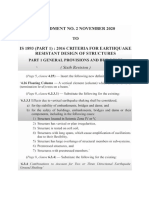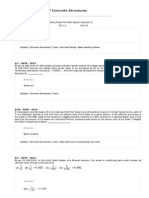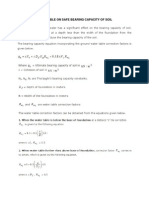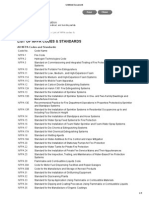0 ratings 0% found this document useful (0 votes) 371 views 103 pages Basics of Engineering Drawing
Engineering Drawing basics explained as per IS Codes
Copyright
© © All Rights Reserved
We take content rights seriously. If you suspect this is your content,
claim it here .
Available Formats
Download as PDF or read online on Scribd
Go to previous items Go to next items
Save Basics of Engineering Drawing For Later 6.1 WHAT IS ENGINEERING DRAWING?
* Engineering drawing is the graphical representation of an object containing all necessary information
like actual shape, size, etc., required for the manufacturing of an engineering component.
* tis the language used to convey engineer's thoughts to a worker in a manufacturing firm, Hence,
Engineering Drawing is also known as the Universal Language of Engineers or Engineer's Language.
6.2 CLASSIFICATION OF ENGINEERING DRAWING
(a) Geometrical Engineering Drawing: The art of representing geometrical object such as rectangle, square,
triangle, cube, cylinder, sphere, elc.,on a paper is called Geometrical Engineering Drawing
Itis further sub-grouped as:
(i) Plain Geometrical Drawing: The art of representing geomettical objects (two dimensional)
such as hexagon, pentagon, rectangle, square triangle, etc.,on papers called Plain Geometrical
Drawing,
(li) Solid Geometrical Drawing: The art of representing geometrical objects (three dimensional)
such as, cubes, cylinders, spheres, pentagonal prism, hexagonal prism, pentagonal pyramid,
exagonal icone, papers metricat Drawing,
(b) Mechanical Engineering Drawing: The art of representing mechanical Engineering objects, such as,
Machines, machine tool parts, IC engine parts, automobile parts, etc., on paper is called Mechanical
Engineering Drawing or Machine Drawing,
(c) Civil Engineering Drawing: The art of representing Cinil Engineering objects, such as, buildings, roads,
bridges, ete., on paper is called Civil Engineering Drawing, |
(d) Electrical Engineering Drawing: The art of representing Electrical Engineering object, such as, electrical
Machines, motors, generators, transformers, etc.,.on a paper is called Electrical Engineering Drawing,
{e) Electronics Engineering Drawing: The art of representing Electronics Engineering objects, such as
electronic circuit, calculators, TV circus, computers, etc, ona paper is called Electronics Engineering
Drawing,
6.3 DRAWING INSTRUMENTS
(a) Drawing board (IS 1444 : 1989)
* Drawing boards are used to provide support to the drawing sheets or papers.
* Top working surface of the board should be smooth in order to prepare quality drawings.
* Drawing boards are made in various sizes. Its selection depends upon the size of the drawing
sheet to be used�mADE ERSY General Principles of Drawing 51
Table 6.1 Standard sizes of drawing boards
Sie | eoaeon | OT |g ee El
toe > aaa
a z 7
lee _ ae
(b) Drawing sheets (IS 10711 : 2001)
ee
rata
i :
| A4
B| (297 « 210)
bl A2
A3
(420 297) r\
pip" AY
5 PW
Al
i
Fig. 6.1 Standard sizes of drawing sheet
* Standard sizes of trimmed drawing sheets recommended by IS 10711 : 2001 are shown in
figure
© The length to width ratio of these sheets is V2 :1
* The surface area of basic AO size drawing sheets nearly 1 m? (119mm x 641 mm)
* The successive sheet sizes are obtainad in the same ratio by halving the length dimension such
that its area is half of area of previous sheet.�52 General Principles of Design, Dray
ing and Importance of Safety ETSI Sener Stuesa
iMate) : Engineering Aptitude
(0). T-square:
‘+ [tis used for drawing horizontal parallel ines,
* loan also be used as a base for drawing the various angles with the help of set squares.
Drawing board
[Ps
Protractor
Edge of the paper
1 ry Tesquare
Fig. 6.2 Arrangement of F-square, set squares and protractor
(a) Set squares:
* Theyare usedto draw paralel, inclined and perpendicular lines, often in conjunction with T-square.
+ There are two types of set squares:
(Thirty-sixty degree (30°-60")
(i) Forty five degree (45°)
(e) Protractor
* They are used for measuring or constructing angles
which cannot be obtained with set squares.
+ They are graduated in degrees, measurable with a
least count of upto 0.5°
(f) Compass and divider
+ Compass is used to draw circles and arch. Large
compass is used for diameter greater than 50 mm and
‘small compass is used for diameter less than 50 mm,
* Dividers used to divide the lines or curves into equal — wn
parts and to transfer the lengths from one place to ® o
other.
a Fig. 7.3 Compass and divider�mane EASY General Principles of Drawing 53
(g) Mini drafter
© It is used for different drafting operations, viz., to draw horizontal, vertical and inclined lines,
parallel and perpendicular lines and also for measuring lines and angles.
ig a madern equipment that combines the advantages of T-square, set squares, protractors,
\d scales which becomes a convenient drafting equipment.
a
Tab Drawing board
P= 1
g { Deawing set
Blades with scale
Para Za felerepean
Fig. 6.4 Fixing the mini drafter on the board
(h) French curves
Fig. 6.5 French curves
«French curves are used for drawing curves thet have different radii and curvatures which cannot
be drawn with a compass.
* continuous smooth curve required through a set of points that do not lie on a straight line or on
a circle can be drawn with the help of french curves.
(i) Pencils
These are the primary tools in engineering drawing, used by engineers to communicate their
ideas through text ar drawing.
+ They are amenable for erasing and making alternations, without causing permanent impressions.
* The grade of a pencil lead is usually shown by alphabets and letters marked at one of its ends,�54 General Principles of Design, Drawing and Importance of Safety STEM eames
* Gracie HB denotes medium soft. Grade H is harcier than HB and H, 2H, etc. denote hardness in
increasing order, Grade B is used to denote softer than HB and B, 2B, etc. denotes softness in
increasing order.
Various grades of pencils available today are as follows
SH, 8H, 7H, 6H, SH, 4H, 3H, 2H, H, F, HB, B, 28, 3B, 48, 58, 68,78, 88 and 98
* The lead may be sharpened to two different forms:
() Conical point and
(il) Chisel edge
* The conical points used in sketch work and for lettering ete.
* With the chisel edgo, long thin lines of uniform thickriesss can
be easily drawn and hence, itis suitable for drawing work
* The chisel edge is prepared by rubbing the lead on a
Sandpaper block, making it lat, first on one side and then on
the other by turning the pencil through a half circle
* For making the conical end the pencil should be rotated
between the thumb and fingers, while rubbing the lead.
Other drawing instruments frequently used are sheet holding
Gevices (drawing clips, cello tapes, pins, ec.) erasers, Wy ous cays ee
sharpeners, sandpaper block, rolkn-draw, etc
Fig. 7.6 |
6.4 ENGINEERING SCALES
|tis not always possible or convenient to draw drawings of an abject to its actual size. For instance,
Crawings of very big objects like buildings, machines, etc., cannot be prepared in ful size because they
would be too big to accommodate on, the drawing sheet. Drawings of very small objects like pracisio
instruments, namely, watches, electronic devices, micro processors etc., also cannot be prepared in ful
size because they would be too small to draw and to read. The different types of scales ised so that
object can be accommodated on drawing sheet and can comfortably be drawn and vead are as follows:
(i) Full size scale
"Fie show tho actual length of an object on a drawing, then the scale used full size scale. Designation
of full size scale: Scale 1:1
(il) Reducing scale
\Fwe reduce the actual length of an object so as to accommodate that object on drawing, then the
Scale used is called Reducing scale. Such scales are used for the preparation of drawings of large
‘machine parts, buildings, architectural drawings, etc. Designation of reducing scale : Scale 1 :
(Example : Scale 1 :20 represents size on drawing is reduced 20 times of actual size)
(iil) Enlarging or increasing scale
Drawing of instruments, watches, etc., aro made larger than their eal size, These are said to be
drawn on an enlarging or inereasing scale. Designation of enlarging scale: Scale x: 1 , (Example:
Scale 20: 1)
(iv) Representative Factor
{tis the ratio of the length of the element on the drawing to the actual length of the element
Length of the abject in drawing
FF = fetual length of he object ("827 units)






